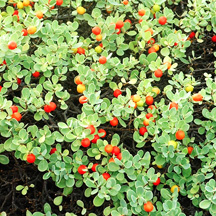|
In The Garden
Guest Writers
|
Akia is just right for people who need a hedge about 3 feet tall
Akia
Wikstroemia uva-ursi
Description: Dense shrubs that either grow prostrate or sprawl 3 to 4 feet tall. They have small, oval, greenish-blue leaves that are attached to reddish-brown branches. When in bloom, many clusters of tiny yellow flowers develop, which turn into small orange or red fruit about three-quarters of an inch in diameter. The flowers have a musky but distinct scent and can be easily noticed from a distance, usually more so in the early evening.
 HUI KU MAOLI OLA
'Akia is available at garden shops such as Home Depot where it cost about $6.
|
|
Distribution: This endemic plant can be seen in many landscapes throughout Honolulu and the rest of the state. It is one of the most used native plants in landscapes today. In the wild it is quite rare, found only in dry, open, often disturbed lowland or coastal habitats on Kauai, Oahu, Molokai and Maui, where it is also reported as far inland as Iao Valley.
Cultural uses: Many members of this genus Wikstroemia were used as a narcotic to catch fish. The bark, roots and leaves were pounded and mixed with bait, then thrown in the water to feed the fish. Upon ingesting, the fish would swim in a "drunken" state, which made them easier to scoop up with a net or to spear. The mashed plant portions are also used in sorcery.
Landscape use and care: This plant has proved itself to be one of the best landscape plants for Hawaii's environment, and not just among native species. They're extremely hardy, requiring very little water, and grow slow enough so that you don't need to maintain them as much once they reach their desired height. Few pests if any bother akia, and their bright colors when in fruit make this plant even more attractive. If you need a low hedge, about 3 feet tall, or a colorful accent plant that is easily shaped, then akia is for you.
Extra info: People often ask if the attractive fruit are poisonous and if they should worry about kids or pets eating them. From what I've heard, it's the stem, leaves and roots that make the fish narcotic, not the fruit, and it only affects coldblooded animals. I've also seen birds eat the fruits daily with no ill effects. Anyway, the fruit taste so bad that any human would immediately spit it out. You can trust me on that -- it's terrible.
Rick Barboza co-owns Hui Ku Maoli Ola, a native Hawaiian plant nursery, with Matt Schirman. Contact him at 259-6580 or e-mail
rickckbarboza@aol.com
Rick Barboza co-owns Hui Ku Maoli Ola, a native Hawaiian plant nursery, with Matt Schirman. Contact him at 259-6580 or e-mail
rickbarboza@aol.com.

